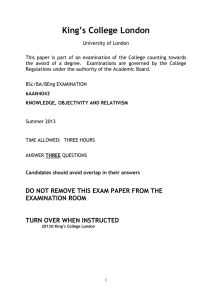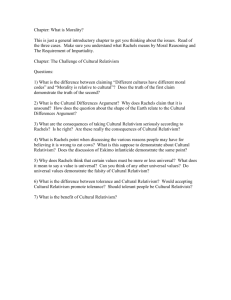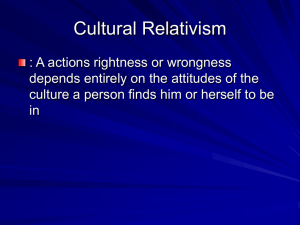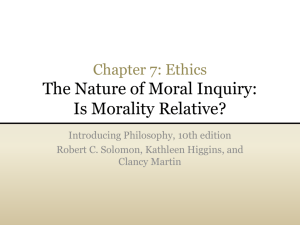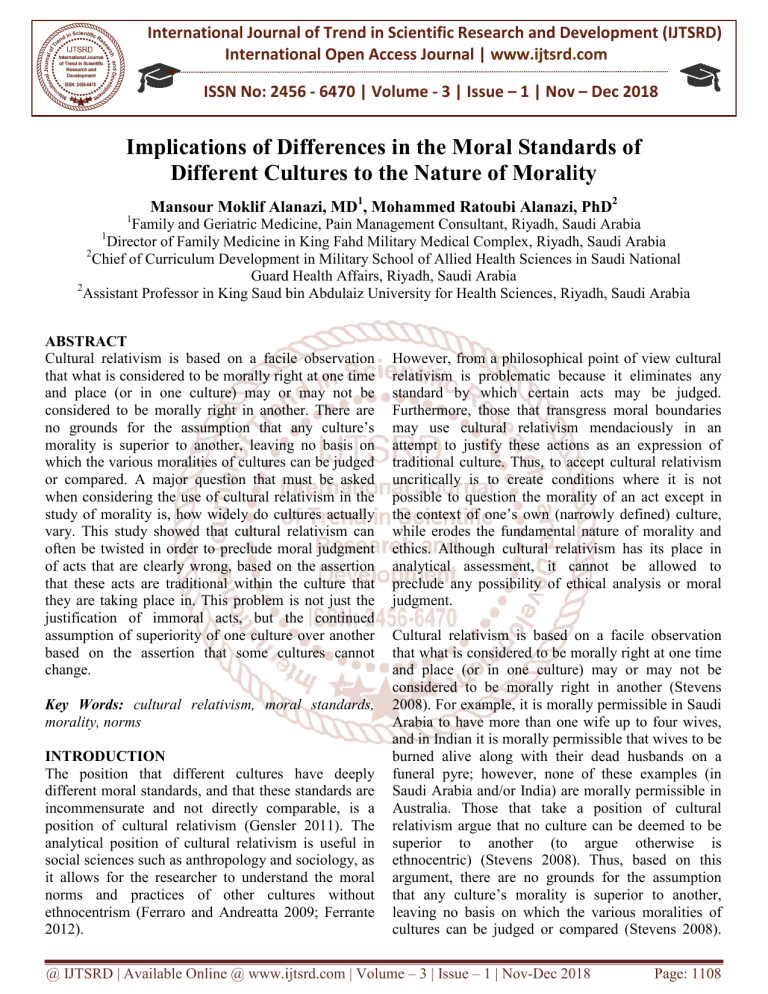
International Journal of Trend in Scientific Research and Development (IJTSRD)
International Open Access Journal | www.ijtsrd.com
ISSN No: 2456 - 6470 | Volume - 3 | Issue – 1 | Nov – Dec 2018
Implications off Differences in the
he Moral Standards of
Different Cultures to the Nature off Morality
1
Mansour Moklif Alanazi, MD1, Mohammed Ratoubi Alanazi, PhD
Ph 2
Family and Geriatric Medicine
Medicine, Pain Management Consultant, Riyadh, Saudi Arabia
Director of Family Medicine iin King Fahd Military Medical Complex, Riyadh,
Riyadh Saudi Arabia
2
Chief of Curriculum
rriculum Development in Military School of Allied Health Sciences in Saudi National
Guard Health Affairs, Riyadh, Saudi Arabia
2
Assistant Professor in King Saud bin Abdulaiz University for Health Sciences
Sciences, Riyadh, Saudi Arabia
1
ABSTRACT
Cultural relativism is based on a facile observation
that what is considered to be morally right at one time
and place (or in one culture) may or may no
not be
considered to be morally right in another. There are
no grounds for the assumption that any culture’s
morality is superior to another, leaving no basis on
which the various moralities of cultures can be judged
or compared. A major question that must bbe asked
when considering the use of cultural relativism in the
study of morality is, how widely do cultures actually
vary. This study showed that cultural relativism can
often be twisted in order to preclude moral judgment
of acts that are clearly wrong, based
ased on the assertion
that these acts are traditional within the culture that
they are taking place in. This problem is not just the
justification of immoral acts, but the continued
assumption of superiority of one culture over another
based on the assertion
on that some cultures cannot
change.
Key Words: cultural relativism, moral standards,
morality, norms
INTRODUCTION
The position that differentt cultures have deeply
different moral standards, and that these standards are
incommensurate and not directly comparable, is a
position of cultural relativism (Gensler
Gensler 2011
2011). The
analytical position of cultural relativism is useful in
social sciences such as anthropology and sociology, as
it allows for the researcher to understand the moral
norms and practices of other cultures without
ethnocentrism (Ferraro
Ferraro and Andreatta 2009
2009; Ferrante
2012).
However, from a philosophical point of view cultural
relativism is problematic because
becau it eliminates any
standard by which certain acts may be judged.
Furthermore, those that transgress moral boundaries
may use cultural relativism mendaciously in an
attempt to justify these actions as an expression of
traditional culture. Thus, to accept cultural relativism
uncritically is to create conditions where it is not
possible to question the morality of an act except in
the context of one’s own (narrowly defined) culture,
while erodes the fundamental nature of morality and
ethics. Although culturall relativism has its place in
analytical assessment, it cannot be allowed to
preclude any possibility of ethical analysis or moral
judgment.
Cultural relativism is based on a facile observation
that what is considered to be morally right at one time
ti
and place
lace (or in one culture)
culture may or may not be
considered to be morally right in another (Stevens
2008). For example, it is morally permissible in Saudi
Arabia to have more than one wife up to four
fou wives,
and in Indian it is morally permissible that wives to be
burned alive along with their dead husbands on a
funeral pyre; however, none of these examples (in
Saudi Arabia and/or India) are morally permissible in
Australia. Those that take a position of cultural
relativism argue that no culture can be deemed to be
superior to another (to argue otherwise is
ethnocentric) (Stevens 2008)). Thus, based on this
argument, there are no grounds for the assumption
that any culture’s morality is superior to another,
leaving no basis on which the various moralities of
cultures can be judged or compared (Stevens 2008).
@ IJTSRD | Available Online @ www.ijtsrd.com | Volume – 3 | Issue – 1 | Nov-Dec
Dec 2018
Page: 1108
International Journal of Trend in Scientific Research and Development (IJTSRD) ISSN: 2456-6470
2456
Instead,
d, the only relation that is possible is between
another culture and one’s personal morality;
statements of X act is wrong must be reduced to I
believe that X act is wrong (Stevens
Stevens 2008
2008). This
eliminates much of the conflict in moral assertions
and assumptions; however, it does not provide a basis
for discerning a science or philosophy of ethics
(Stevens 2008). It also does not prepare
pare the individual
for an increasingly globalized world, in which the
moralities of different cultures, rather than being
strictly contained within a geographical region are
constantly in contact and in conflict (Stevens
Stevens 2008
2008).
Thus, one of the major perils of cultural relativism in
regard to the nature of morality is that it reduces
morality to a personal set of beliefs and constructs,
rather than a meaningfully shared set of beliefs.
A majorr question that must be asked when
considering the use of cultural relativism in the study
of morality is, how widely do cultures actually vary?
Stevens (2008) argues that in actuality, the basic
principles of morality do not vary significantly
between cultures;
tures; instead, it is only the derived
expressions of morality (the manners and behavioural
norms) that vary greatly. Many universal basic
principles, such as prohibitions against lying, killing
members of one’s own society, and incest, derive
from the duall nature of humans as social, yet selfish,
creatures (Stevens 2008).. These principles serve to
hold societies together by prescribing limits to the
expression of selfishness of the individual;
furthermore, these principles are consistent because
the basic rules by which human societies are
organized are consistent (Stevens 2008)..
There are many cases, even in the extreme
extreme, where a
seemingly disparate set of norms and practices can be
reduced to similar principles. One example is the
practice of female infanticide among Eskimo groups
(Rachels and Rachels 2010).. On its face, this is a
morally wrong practice to Western eyes, as infants are
to be protected and not killed. However, in the
Eskimo
mo context of scarce food supplies, long nursing
periods, and the dramatically greater risk to adult
males than females, this makes sense; it is an act
performed in recognition of the need to provide
resources for the existing group (an expression of the
social
ocial nature of humanity) and the limitations imposed
by the environment (Rachels
Rachels and Rachels 2010
2010). This
example shows that in order to understand cultural
practices, it is necessary to look below the first level
of norms and practices and examine the underlying
moral principles that are at work in generating these
norms and practices before it is possible to understand
how a practice comes about. Thus, the similarity of
core values (even in the face of widely varying
practices) requires not acceptance of cultural
relativism as an analytical position, but instead a
deepening
ing of the analysis to get at these core values.
The effects of applying cultural relativism to the
nature of morality
These arguments are not meant to indicate that
cultural relativism should have no role in the study of
ethics. As Bond (1996) points out, there are important
uses for cultural relativism in ethics. In particular,
cultural relativism is a means of overcoming
psychological egoism, or the assumption that one’s
own moral standards are the correct or right moral
standards (or alternatively
ively the only standards that are
moral). Cultural relativism, by its removal of the
assumption of universal morality and substitution of
the understanding that moral standards vary widely by
time and place, allows for the elimination of the self
in the assessment
sessment of morality and critique (Bond
1996).
However, Bond also notes that this view frequently
freq
reduces morality to mere standards of behaviour or
manners, which is not truly reflective of underlying
norms regarding morality and its practice (Bond
1996).. Thus, even though cultural relativism has a use
in Bond’s (1996), it must not be used to reduce ethical
standards to simple behavioural standards, since this
once again reduces morality to the level of the
individual rather than a shared society. In particular,
while this removal of psychological egoism from a
position of importance in analysis does mean that a
particular injustice of Western academic research –
the assumption of Western society’s
soc
superiority over
others – is removed; it also removes the ability to
critique practices that are by most standards immoral
(Rachels and Rachels 2010)). One example is the
authoritarian practices of the Chinese state, which
include brutal repression of political dissent, including
armed military action against unarmed civilians;
under a cultural relativism viewpoint, there is nothing
to say about this practice, which must simply be
accepted because it is accepted within Chinese culture
(Rachels and Rachels 2010).. In addition,
addition of course
overlooking the obvious problem (that if this
behaviour were actually accepted within Chinese
culture there would be no dissent to repress), it also
reduces any critique of this regime to that of personal
@ IJTSRD | Available Online @ www.ijtsrd.com | Volume – 3 | Issue – 1 | Nov-Dec
Dec 2018
Page: 1109
International Journal of Trend in Scientific Research and Development (IJTSRD) ISSN: 2456-6470
2456
disagreement, not a meaningful statement regarding
right and wrong. Thus, although cultural relativism is
useful in a limited fashion, it must nnot be used to
simply refute the notion of morality as a whole.
There are many other examples that demonstrate the
ways in which cultural relativism reduces the
understanding and practice of morality. One example
is the human rights practices of Ira
Iran, including
executions, imprisonments, and the repression of
women (Afshari, 2011).. These practices are routine
and justified by the Iranian government under the
mantle of traditional cultural practice and religion,
which is intended to have the effect of insulating them
from outside critique (Afshari 2011).. However, Iran is
far from the only government
vernment that uses claims of
tradition and culture to shield itself from critique
regarding its actions. For example, the Israeli
government makes many of the same claims,
including a claim to traditional rights to the land,
religious claims, and justice-seeking
eeking from prior
persecution, to justify its treatment of Palestinians
within its borders (Strong 1998).. In fact, Strong
(1998) identifies the same drivers of these positions of
opposing states att work in these two cases. How using
cultural relativism in such this conflict to be resolved?
The facile resolution offered by Stevens (2008) is of
no use in this situation; even if the problem is
reframed, as X believes Y is wrong and vice versa,
there is still the potentially violent disagreement of
large and well-armed
armed states to contend with. Thus,
cultural relativism has limited use in practical
applications of morality and ethics, as it precludes any
useful solution.
This is a point reiterated by authors discussing N
Non
Governmental Organizations (NGOs) participation in
global civil society, who point out that societies no
longer stop at international borders; instead, the
position of judgment of a state’s actions is now
international and global (Clark,
Clark, Friedman et al.
October 1998). Thus, the argument of a sovereign
state that its actions are moral because they are
appropriate under the norms of that society is no
longer valid. Furthermore, the position that some
societies must retain norms because they are
traditional implies an on-going oriental’s viewpoint
that underhandedly continues to assert the unchanging
and static nature of non-Western
Western societies.
Orientaliste thought is at the centre of the colonialist
activity, and its core principle is that some societies
(Western societies) are superior to others, among
other reasons because they have the ability to grow
and change (Said 2003).. Thus, to assert in the face of
international disapprobation of a given cultural
practice that it must not be criticized
criticize because it is a
cultural practice, as both Iran and Israel insist upon, is
to remove the power of cultural relativism to
eliminate hierarchies of cultures. This use of cultural
relativism actually reinstates the position of moral
superiority, when its rejection
jection is one of the main uses
of the principle in the first place.
This leaves the question of morality and biology. A
strict position of moral universalism would imply that
morality was in some sense encoded in our genes, and
that it was an innate
ate physical or cognitive
characteristic of humans. A study suggests that
morality and ethics are an expression of culture, not of
nature, and that this means that there is no universal
nature of morality; thus, we must accept the position
of cultural relativism,
tivism, reducing ethical standards
differences to simple disagreements (Nitecki and
Nitecki 1993).. However, there are other arguments
that suggest that morality does have an evolutionary
purpose, and that it evolved alongside the evolution of
Homo sapiens as a social mammal as a means of
improving fitness (Campbell
Campbell 1998).
1998 Under this view,
morality plays an important role in ensuring the
survival of the group, which is the main aim of
sociality among humans (Campbell
Campbell 1998).
1998
The evolutionary role of morality does not imply that
all human cultures will have the same expression of
morality, as humans are among the most elastic (or
individually adaptable) of all species and various
genetic traits are expressed differently
dif
depending on
environment (Bogin 1999). There is also evidence that
the basic structures of human society demand
d
the
development of core principles and practices (i.e.
morals) even when the environment generates
pressures for the evolution of different norms and
practice (i.e. manners) (Rachels
Rachels and Rachels 2010).
2010
Thus, it is simplistic to say that cultural relativism
must simply be accepted because morality is not
biologically determined; in fact, the biological
determination of morality
lity is not clearly understood,
and it cannot be presumed that the basic principles of
morality as an enabler of social organization are not
biologically determined.
Conclusion
This article has elaborated on a number of points
regarding cultural relativism. First, it is fundamentally
@ IJTSRD | Available Online @ www.ijtsrd.com | Volume – 3 | Issue – 1 | Nov-Dec
Dec 2018
Page: 1110
International Journal of Trend in Scientific Research and Development (IJTSRD) ISSN: 2456-6470
2456
destructive to the idea of shared morality because the
only determination that can be made from a culturally
relativist standpoint is that an act is pers
personally
immoral, rather than a statement of comparison of
wider culture. Furthermore, it demonstrated that the
basis of cultural relativism – that the moral norms and
values of cultures vary widely – is often overstated
and thus that the use of moral relati
relativism in the
analysis of morality is not actually as useful as it may
be. Then, this article demonstrated the contrary to
cultural relativist arguments that morality is strictly
cultural, there are in fact evolutionary reasons for the
development of moralityy and as such it is not possible
to strictly exclude the study of morality as a biological
trait of humans.
Finally, it showed that cultural relativism can often be
twisted in order to preclude moral judgment of acts
that are clearly wrong, based onn the assertion that
these acts are traditional within the culture that they
are taking place in. This problem is not just the
justification of immoral acts, but the continued
assumption of superiority of one culture over another
based on the assertion thatt some cultures cannot
change. Although there are some analytical uses of
cultural relativism, such as reducing the tendency to
psychological egoism, ultimately cultural relativism,
if accepted uncritically, precludes the study of
morality entirely and reduces
uces this study to an assertion
of personal opinions about acts. This substantially
reduces, if not eliminates, the strength of morality as a
basis of judgment.
REFERENCES
1. Afshari, R. (2011). Human rights in Iran: The
abuse of cultural
al relativism. Philadelphia,
University of Pennsylvania Press.
2. Bogin, B. (1999). Patterns of human growth.
Cambridge Cambridge University Press.
4. Campbell, B. (1998). Human evolution: An
introduction to man's adaptation. New Jersey,
Transaction Publishing.
5. Clark, A. M., E. J. Friedman, et al. (October
1998). "The sovereign limits of global civil
society: A comparison of NGO participation in
UN World Conferences on the Environment,
Human Rights, and Women." World Politics 51:
1-35.
6. Ferrante, J. (2012). Sociology: A global
perspective. Belmont, WADSWORTH: Cengage
Learning.
7. Ferraro, G. and S. Andreatta (2009). Cultural
anthropology: An applied perspective. Belmont,
WADSWORTH: Cengage Learning.
8. Gensler, H. J. (2011). Ethics: A contemporary
introduction. New York, Taylor & Francis Group.
9. Nitecki, M. H. and D. V. Nitecki, Eds. (1993).
Evolutionary ethics. Albany, University of New
York Press.
10. Rachels,
ls, J. and S. Rachels (2010). The elements of
moral philosophy New York, McGraw-Hill.
McGraw
11. Said, E. W. (2003). Orientalism. New York,
Knopf Doubleday Publishing Group.
12. Stevens, D. (2008). "Cultural Relativism and the
Nature of Morality." Retrieved 23 March 2012,
2012
from
http://www.bioethicseducation.com/attachments/0
27_Cultural%20Relativism%20and%20the%20Im
plication%20for%20the%20Nature%20of%20Mor
ality.pdf.
13. Strong, S. I. (1998). "Law and Religion in Israel
and Iran: How the Integration of Secular and
Spiritual Laws Affectss Human Rights and the
Potential for Violence." Michigan Journal of
International Law 19: 109--115.
3. Bond, E. J. (1996). Ethics and human well
well-being:
An introduction to moral philosophy. Oxford,
Blackwell Publishers Ltd.
@ IJTSRD | Available Online @ www.ijtsrd.com | Volume – 3 | Issue – 1 | Nov-Dec
Dec 2018
Page: 1111

